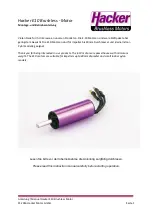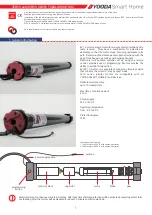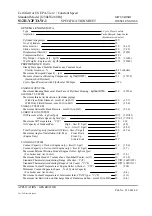
Jabiru Aircraft
Pty Ltd
Instruction & Maintenance Manual
Jabiru 2200 Aircraft Engine
Hydraulic Valve Lifter Models
This document is controlled while it remains on the Jabiru server. Once this no longer applies the document becomes uncontrolled.
REVISION
0
1
2
3
4
5
6 7
8
9
Dated : June 2010
Issued By: DPS
Page: 74 of 116
L:\files\Manuals_For_Products\Engine_Manuals\Transition\JEM2204-9_I&M_unsigned.docx
then all to 34 Nm (25 lb.ft), and finally all to 40 Nm (30 lb.ft).
This operation
must be done in one session so the Loctite does not cure before the final
torque is applied to the cap screws.
CAUTION
Over-tightening propeller flange screws can damage the screws and/or the
crankshaft. Ensure torque wrench is properly calibrated & do not over-
tension screws
12. Lock-wire screws in pairs if a standard prop flange is used. Note: Where prop
flange extensions are used the cap screws are not lock wired.
13. Allow the retaining compound time to cure (refer to manufacturer specifications)
before starting the engine.
CAUTION
If for any reason prop flange or prop has been damaged, rear flywheel cap
screws are to be replaced.
7.5.1.12
Engine Run In
When built, the Jabiru engine is run in on a DYNOMOMETER and cooled with fan driven
air. In the absence of a DYNO controlled run, engines can be run-in in the airframe. Very
large air ducts must be constructed to get adequate airflow for cooling in the static
situation. The flying air ducts must not be used for this purpose. Extreme care must be
taken with the cylinder head temps if run in is done in the airframe. Engine run in
procedure allows progressive build up of the B.M.E.P. (break mean effective pressure) in
the cylinders while carefully limiting the heat build up. In essence short amounts of hard
work increasing in intensity while limiting the heat build up is the format. This can be seen
in detail after the engine build sheets.
All engines are run in before delivery - including
overhauled engines. When delivered they are ready for flight. See early run section
4.7 for first 25 hours of operation.
Run Procedure to be used only if engine has not been run-in.
i)
Mount Engine on test rig (See engine installation)
ii)
Fill with non detergent oil.
iii)
Remove spark plugs and wind over until oil pressure is reached.
iv)
Fit plugs and cooling ducts.
v)
Run in. Follow run in program.
vi)
Cool down (at least 12 hours)
vii)
Retorque heads
viii)
Rerun
ix)
Check leak down
Note: There is a run in program and run in checklist to fill out.
















































